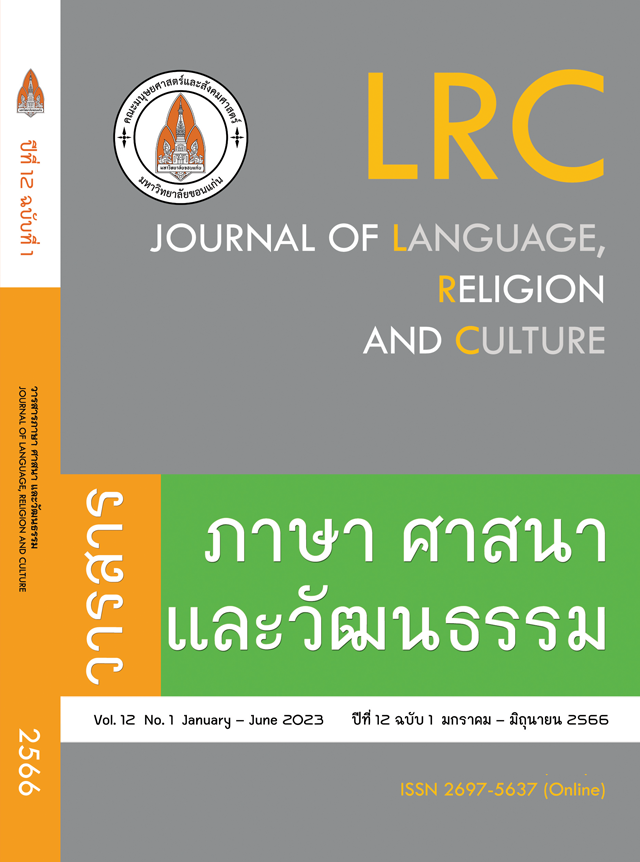การใช้บุพบทวลีที่แสดงเหตุและผลในงานแปลนิทานพื้นบ้านจากภาษาไทยเป็นภาษาเยอรมัน กรณีศึกษา นิทานไกรทอง
การใช้บุพบทวลีที่แสดงเหตุและผลในงานแปลนิทานพื้นบ้านจากภาษาไทยเป็นภาษาเยอรมัน กรณีศึกษา นิทานไกรทอง
คำสำคัญ:
การแปล, นิทานพื้นบ้าน, บุพบทวลีบทคัดย่อ
บทความนี้ มุ่งเพื่อศึกษาวิเคราะห์บทบาทหน้าที่ทางไวยากรณ์ในการใช้บุพบทวลีที่แสดงเหตุผลในงานแปลนิทานพื้นบ้านเรื่องไกรทองจากภาษาไทยเป็นภาษาเยอรมัน เพื่อแสดงให้เห็นถึงรูปแบบการใช้ภาษาในการถ่ายทอดภาษาปลายทาง (Zieltext) ให้มี ความกระชับ สื่ออารมณ์ความหมายได้ชัดเจน ไม่สูญเสียเนื้อหาที่แท้จริงของภาษาต้นฉบับ (Ausgangstext) ในการศึกษาครั้งนี้ ผู้เขียนบทความได้เก็บข้อมูลและวิเคราะห์ประโยคทั้งหมดที่เกี่ยวข้องกับบุพบทวลีที่แสดงเหตุและผลในงานแปล ทดแทนโครงสร้างประโยคที่ประกอบไปด้วยประโยคหลัก (Hauptsatz) และอนุประโยค (Nebensatz) โดยเลือกศึกษาเฉพาะบุพบทวลีที่แสดงเหตุและผล (kausal) ตามหลักไวยากรณ์เยอรมัน ซึ่งมีบุพบทวลีทั้งหมด 4 รูป ประกอบไปด้วย (aus Angst / aufgrund / wegen / vor Zorn) และจากการวิเคราะห์ข้อมูล นำไปสู่ข้อสรุปได้ว่า 1) บุพบทวลีมีหน้าที่ทางภาษาในการการถ่ายทอดภาษาปลายทาง (Zieltext) ให้มีความกระชับ สื่ออารมณ์ความหมายได้ชัดเจน โดยไม่สูญเสียเนื้อหาที่แท้จริงของภาษาต้นฉบับ (Ausgangstext) 2) บุพบทวลีสามารถสื่อความหมายในเชิงการแสดงเหตุและผล ได้ดีกว่าคําคุณศัพท์ทีอาจมีความหมายใกล้เคียงกัน เช่น vor Zorn และ zornig เมื่อวิเคราะห์ความหมายในระดับต้น จะเห็นว่า สองคำนี้เป็นคำที่มีความหมายเหมือนกัน แต่เมื่อผู้แปลวิเคราะห์ภาษาต้นฉบับในระดับที่ลึกซึ้งขึ้น พบว่า ประโยคต้นฉบับในภาษาไทยนั้นสื่อความหมายในเชิงการแสดงเหตุและผล (kausal) ดังนั้น คำว่า vor Zorn จึงมีความหมายที่ถูกต้องในการถ่ายทอดไปสู่ภาษาปลายทาง และเหมาะสมกว่าคำว่า zornig ซึ่งเป็นคำที่สื่อความหมายในเชิงวิธีการ (modal) และ 3) บุพบทวลี vor Zorn มีบทบาททั้งในเชิงวากยสัมพันธ์และเชิงความหมาย โดยสามารถทําหน้าที่เป็นวลีหรือสํานวน (Idiomatische Wendungen) ได้ด้วย เมื่อวิเคราะห์ในเชิงความหมาย (semantisch) จากข้อเท็จจริงนี้ สามารถวิเคราะห์ต่อยอดไปอีกได้ว่า การใช้วลีหรือสำนวน ในงานแปล ย่อมแสดงให้เห็นถึงรูปแบบลีลาการใช้ภาษา (Stil) ของผู้แปล ในการเลือกใช้วลีหรือสำนวนภาษาที่เหมาะสม ในการถายทอดอารมณ์ความรู้สึกที่ถูกแฝงไว้ในภาษาต้นฉบับ
เอกสารอ้างอิง
พจนานุกรมศัพท์ภาษาศาสตร์ (ภาษาศาสตร์ประยุกต์) ฉบับราชบัณฑิตยสถาน (2553). กรุงเทพมหานคร :
ราชบัณฑิตยสถาน.
วิเชียร เกษประทุม. (2540). นิทานพื้นบ้านสำหรับเด็กและเยาวชน. กรุงเทพมหานคร: สำนักพิมพ์พัฒนา
ศึกษา.
สุพรรณี ปิ่นมณี (2562). ภาษา วัฒนธรรมกับการแปล: ไทย-อังกฤษ. กรุงเทพมหานคร : สำนักพิมพ์
จุฬาลงกรณ์มหาวิทยาลัย.
Albrecht, J. (2013). Übersetzung und Linguistik. 2. Auflage. Tübingen: Narr Francke
Attempto Verlag.
Duden. (2006). Die Grammatik. Mannheim: Dudenverlag.
Koller, W. (2011). Einführung in die Übersetzungswissenschaft. Tübingen: Narr Francke
Attempto Verlag GmbH & Co.KG .
Pittner, K. (2016). Einführung in die germanistische Linguistik. 2. Auflage. Darmstadt:
Wissenschaftliche Buchgesellschaft.
Watchakaweesilp. Wassamill (2014). Krai Thong. Ein literarisches Übersetzungswerk.
Faculty of Humanities and Social Sciences, Khon Kaen University, Khon Kaen,
Thailand.
ดาวน์โหลด
เผยแพร่แล้ว
รูปแบบการอ้างอิง
ฉบับ
ประเภทบทความ
สัญญาอนุญาต
ลิขสิทธิ์ (c) 2023 วารสารภาษา ศาสนา และวัฒนธรรม

อนุญาตภายใต้เงื่อนไข Creative Commons Attribution-NonCommercial-NoDerivatives 4.0 International License.







